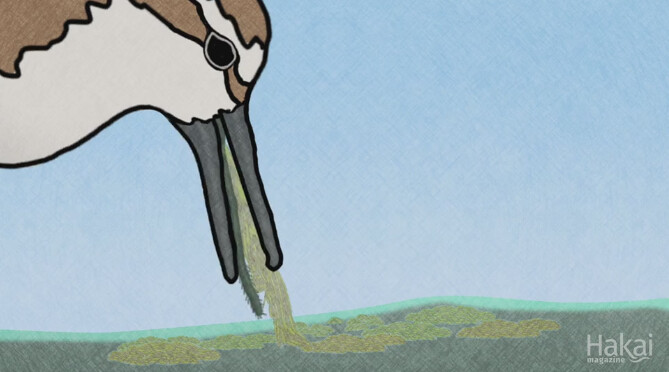15 November 2016
Daniel Wood, Hakai Magazine

Western Sandpipers slurp up biofilm forms on the mudflats with their special bristly tongues © Hakai Magazine
As the tide pulls out over British Columbia’s Roberts Bank on an early October morning, it pools amid the hummocks, follows intertidal runnels seaward, and leaves a silvery-green sheen on the exposed mudflats where Canadian researcher Bob Elner walks. Thousands of southbound snow geese, propelled skyward by a hawk’s approach, move in ever-shifting murmurations to Elner’s right. Dunlin and ducks grub along the tideline to his left. But the western sandpipers, he observes, are gone. A scientist emeritus at Environment and Climate Change Canada, Elner has long studied the sandpipers, and he knows they have headed south on their 10,000-kilometer fall migration from the Arctic to Latin America.
The big unspoken question hanging over these mudflats is how long the sandpipers and other shorebirds will continue to stop on the Fraser River estuary and fuel up, before flying onward. Beyond Elner, as he struggles to maintain his balance on the treacherous mud, rise the silhouetted loading cranes of Deltaport, which lies at the end of a causeway jutting into the Strait of Georgia. Trainloads of coal (bound for Asia, Europe, and South America) and containers of manufactured goods (bound for Canada) arrive there every hour, 364 days of the year. Now the Vancouver Fraser Port Authority is proposing to double the container capacity of this facility by building nearby an entirely new island, called Roberts Bank Terminal 2, at a cost of more than CAN $2-billion. <Read more>
Original article: https://www.hakaimagazine.com/article-long/slime-shorebirds-and-scientific-mystery
Relevant article: http://www.portvancouver.com/news-and-media/news/roberts-bank-terminal-2-project-review-panel-announced/
Hakai Magazine explores science, society, and the environment from a coastal perspective. The magazine is part of the Tula Foundation and Hakai Institute family. While proudly independent, Hakai Magazine shares the same philosophies as the Tula Foundation, celebrating exploration, discovery, and science. The name Hakai is inspired by the Hakai Lúxvbálís Conservancy, the largest protected marine area on the west coast of Canada, located about 400 kilometers north of Vancouver.





